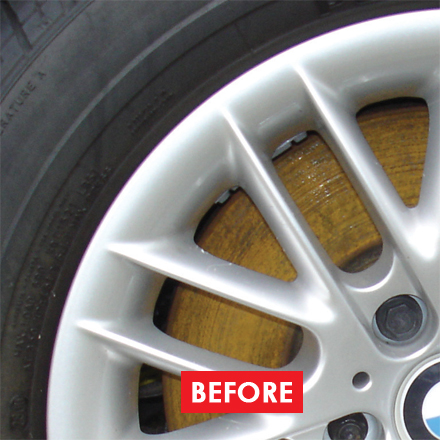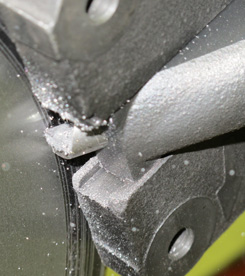+49 (0) 5139 278641
Brake Disc Lathes are profit generators! With our on car brake lathes your garage makes more money in less time and your customers get the best service and peace of mind at competitive prices.
Our on vehicle brake lathes resolve judder & brake efficiency issues. They remove rust. They make extra profit when fitting pads. Running costs just £0.50 per disc!
Call us now to book a demo.

pka of hcl
pK a values given in the table are measuered at 25°C, unless other temperature(°C) is indicated with superscript at the pKa value.. See also Acid-base properties of aqueous solutions of salts with ions from both acids and bases, Buffer solutions, pKa of amines, diamines and cyclic organic nitrogen ⦠Applied Measurement Science » Acidity of strong acids (pKa ... Notice how the equation has given us the Ka of the acid, not the pKa, giving us an extra step in calculating the pH. 1993; Sham et al. H 43 H H 46 CH 3-C H 3 50 A discussion of acid-base terminology is available here. Determine what the pKaâs of the titratable protons are by looking at the pKa table 2. Buffers pKa range . An Introduction to the Acid Dossociation Constant (pKa) pKa Values INDEX - Organic Chemistry Data H+ OFF Apply same rules if there are 3 titratable protons: 1. FT-611531 Ammonium chloride H 3 O + is given by water is neglected because dissociation of water is very low compared to the acetic acid dissociation. Burning fossil fuels for the generation of electric power is the factor most responsible for forming these acid-producing gases. pka1 and pka2 A lower pKa value indicates a stronger acid. This means that HCl will give up its protons to water essentially completely to That is, the lower value indicates the acid more fully dissociates in water. Acidity-Basicity Data (pK a Values) in Nonaqueous Solvents (and some in water as well). Remember that a pKa table ranks molecules in order of their acidity, from strongly acidic (e.g. A lower pKa value indicates a stronger acid. pKa PKa ⢠Similar to pH, the value of Ka can also be represented as pKa. Whereas HCl has a pKa of -6.3 in water, its pKa in acetic acid will be less acidic (greater numerically). A lower pKa value indicates a stronger acid. Sodium hydroxide has a chemical formula of NaOH and is also referred to as lye or caustic soda. Hydrogen chloride can be formed during the burning of many plastics. The opposite of an exponential value is the logarithm. The acid dissociation constant, or Ka, is a way of ranking the strength of acids. A mixture of a weak acid and its conjugate base (or a mixture of a weak base and its conjugate acid) is called a buffer solution, or a buffer. Nitric Acid - HNO. Each amino acid has its own pKa (and pI), but can vary according to how many other amino acids are surrounding your target amino acid. It may be a larger, positive number, such as 30 or 50. Muriatic acid is the common name of industrial-grade hydrochloric acid (HCl). The highlighted papers contain large amounts of pK a data (or other information): acids â red, bases â blue, both acids and bases â purple. A lower pKa value signifies the kind of acid that dissociates totally in water. Hydrogen chloride has many uses, including cleaning, pickling, electroplating metals, tanning leather, and refining and producing a wide variety of products. A lower pKa value indicates a stronger acid . pKa Data Compiled by R. Williams pKa Values INDEX Inorganic 2 Phenazine 24 Phosphates 3 Pyridine 25 Carboxylic acids 4, 8 Pyrazine 26 Aliphatic 4, 8 ... Glyceric acid 2-phosphate 3.6, 7.1 53 CH2CI- 1.40, 6.30 57 Enolpyruvic acid 3.5, 6.4 53 CH2Br- 1.14, 6.52 57 Methyl- 1.54, 6.31 55 0.1 mol dm-3 NaOH 25 cm 3 with 0.1 mol dm-3 HCl. : sal ammonium CAS: 12125-02-9 EC number: 235-186-4 EINECS: 231-420-4 + Cat. For your convenience, the biological buffers table contain values of pKa 0, d(pKa 0)/dt at 298.25 K, and a calculator that allows you to estimate pKa values of each buffer at temperatures form 3 o C to 37 o C, and concentrations from 1 to 500mM for "white background" buffers and 1 to 130mM for "brown background" buffers. Theoretical background. Follow Us: The Ka of HCl is 1.3 x 10^6. base of an acid with a higher pKa value. Ka and pKa. acidic H for which the pKa value is provided is indicated in bold red . pKa is the negative log of the acid dissociation constant or Ka value. And so the acid that we add is going to react with the base that's present in our buffer solution. Methamphetamine hydrochloride acts by facilitating the release of catecholamines, particularly noradrenaline and dopamine, from nerve terminals in the brain and inhibits their uptake.This leads to an increase ⦠Calculation of the Buffer Capacity. 8.08. That is, the lower value indicates the acid more fully dissociates in water. It helps to think of the three hydrohalic acids as covalent molecules (especially HCl, since that is what we are discussing). The lower the pKa value, the stronger the acid. Upon contact with water, it forms hydrochloric acid. What is the pKa of phosphate buffer? ⢠Most biological compounds are weak acids or weak bases. Therefore, its Ka approaches infinity. NaOH and HCl react 1:1 ratio according to the stoichiometric equation. A lower pKa value indicates a stronger acid. ⢠pKa = -log Ka. If pKa is negative it means the acid form of the conjugated pair (HDMF+, protonation at the nitrogen) is a strong acid, i.e. Negative log of 2.9 times 10 to the negative 16. Acidrain hasmany deleterious effects. The pK a values of the carboxyl group and the ammonium group of an amino acid, as well as the pH i, can be determined by titrating the conjugate acid with base. 1A, H314 Eye Dam. 1 ). HI. HCl pKa=-10 c=0.1 Case 2. Tris salts are also ⢠The larger the pKa, the weaker the acid. In addition, the smaller the pKa value, the stronger the acid. Acids are classified as either strong or weak, based on their ionization in water. it does not exist in water. ), Ionization Constants of Organic Acids in Solution, IUPAC Chemical Data Series No. The pKa of acetic acid is 4.76. Tris HCl is especially useful in downstream purification processes. Hydrochloric acid is a strong acid and has complete dissociation in aqueous solution. Acids with lower Ka values are called weak acids. The two views yield two different pKa values.When NaOH is viewed as an acid, its conjugate base is O^{-2}. A pKa may be a small, negative number, such as -3 or -5. Hydrochloric Acid - HCl 0-2 . TrisâHCl (pKa = 8.06) and maleate (pKa = 6.26) have a working range of pH 5.0â8.6 and may be used successfully to buffer staining solutions (e.g., Toluidine Blue O).Avoid Tris with aldehyde fixatives or osmium tetroxide, however, as the aldehydes reacts with the amino group of Tris, resulting in the loss of buffering capacity. Hydrochloric acid is an important laboratory reagent and ⦠A robust acid is defined as an acid with a pKa value less than or equal to around -2. K a = [CH 3 COO â][H 3 O +] [CH 3 COOH] =1.74x10â5 M acidic H for which the pKa value is provided is indicated in bold red . We can easily convert back into Ka: Converting between pKa and Ka. For example, acetic acid CH 3 COOH has a Ka of 1.8×10-5. The acidity orders are different in water, MeCN, DCE and the gas phase. H 43 H H 46 CH 3-C H 3 50 Water is a weak acid with a 15.7 pKa value. For strengths of organic acids see E. P. Serjeant and B. Dempsey (eds. pH of Common Acids and Bases. HClO 4. The acid dissociation constant for an acid is a direct consequence of the underlying thermodynamics of the dissociation reaction; the pK a value is directly proportional to the standard Gibbs free energy change for the reaction. The amount of glycine left after the titration was: 2 meq â 1.4 meq = 0.6 meq. Both hydrogen chloride and hydrochloric acid are corrosive. Equilibrium Constants Ka and Kb: pKa, pKb. H. 2. For example, the pKa of acetic acid is 4.8, while the pKa of ⦠If the pKa ⦠Hazards of HCl, or hydrochloric acid, include both acute and chronic effects. Acute effects include corrosion to the eyes, skin and mucous membranes as well as pulmonary and upper respiratory irritation. Chronic effects include gastritis, bronchitis and dermatitis among those frequently exposed to the substance. 3 . In this step, the logarithmic value is determined. HCl Cl H F N NO3 SH TsO-HCO3 N O O-10-9-8-3.6-2.4-1.7-1.3 4.7 4.8 3.2 sulfuric acid hydroiodic acid hydrobromic acid protonated ether protonated alcohol hydronium ion nitric acid hydrofluoric acid hydrogen nitride carboxylic acids protonated ketone-7.3 6.37 7 carbonic acid tosic acid -0.6 protonated pyridine 5.2 pKa Chart Acids can be categorized into two, based on their ability to dissociate and produce protons. When an acetic acid (sodium) buffer solution is prepared from 1:1 acetic acid and sodium acetate, for example, the buffer solution pH is approximately 4.7 (near the acetic acid pKa), and this is where the maximum buffer action can be obtained. The pKa value is one method used to indicate the strength of an acid. Glacial acetic acid is a powerful solvent, but not as polar as water. But I don't think there is any consequences because, as the article explains, the ⦠The pKa of potassium Phosphate is 7.2. HCl, KAc and KCl: Î = Î + Î Equation 4 Now present the expression for the equilibrium constant, ð¾ð¾ , with expressed as a molarity:c ð¾ð¾ = ð¼ð¼ ðð 1âð¼ð¼ Equation 5 The equilibrium constant for the dissociation of acetic acid obtained using this For example, at 25°C: acetic acid: K. a = 1.8 x 10-5. phenol: K. a = 1.0 x 10-10. When you ask what the pKa of NaOH is, are you viewing NaOH as an acid or a base? Aside from the qualitative comparison of the acid strength, we need a quantitative definition for the acid strength. In some cases â notably, the hydrohalogenic acids HCl, HBr and HI â the differences are dramatic. A lower pKa means the Ka value is higher and a higher Ka value means the acid dissociates more readily because it has a larger concentration of Hydronium ions (H 3 O +).. Thereof, how does pKa relate to acid strength? Key Takeaways: pKa Definition The pKa value is one method used to indicate the strength of an acid. pKa values of Carboxylic acids, Alcohols, Phenols , Amines. The recorded volume and pH values will generate titration curves that will be used to compare features of the strong acid curve versus the weak acid curve. As base is added, some of the conjugate acid is converted to the zwitterion, and the pH increases. Tris HCl has a pKa of 8.08 at 25°C and pH range of 7.0 to 9.0 that coincides with the physiological pH of most living organisms because of which it is commonly used as a component of buffer solutions in biology, biochemistry and molecular biology applications. Acetic Acid Ka = 1.7×10^-5; â log Ka = -4.76, therefore pKa = 4.76. To take an example, consider the ⦠Calculated pH values of common acids and bases for 1, 10, and 100 mmol/L (valid for standard conditions at 25, 1 atm; acidity constants are taken from here ): The limited solubility of hydroxides is taken into account (as indicated by footnotes in the last column). pH versus pKa â¢So 100 molecules of HCl dissolved in water will give you the same pH as 1000 molecules of acetic acid! Volume required to reach equivalence point was 18.4 mL. pKa is the negative log of the acid dissociation constant or Ka value. pKa = -log 10 K a The lower the pK a value, the stronger the acid.For example, the pKa of acetic acid is 4.8, while the pKa of lactic acid is 3.8. 2 4. For example, since acetic acid has a pKa value of about 4.7, when the pH is equal to that pKa, the proportion of acetate to acetic acid would be 1:1. The active ingredient in vinegar is acetic acid, which is a weak acid. =-7. The ionisation of HCl can be shown as: $$HCl + H_2O -> H_3O^+ + Cl^-$$ $$K_a$$ can be calculated as the ratio of the product of the concentrations of the products to that of the reac⦠Even though HCl is a strong acid we can still express its. The pKa is one of the methods that can be used to denote an acid's strength. Calculate the pKa of the acid: pKa = -log 10 (Ka) = -log 10 (1.34×10-5) pKa = 4.87 3. HCl with pKa of â8) to weakly acidic (e.g. Hydrochloric acid . All acids shown here are monoprotic; that is, only one of the bolded H âs will be lost. If you cannot find the data that you need, please contact ivo.leito [at]ut.ee. If the pKa of the acid is low (negative), then the acid is strong . Key Takeaways: pKa Definition The pKa value is one method used to indicate the strength of an acid. Can pKa be negative? of NaOH. Perchloric Acid â HClO. This value is greater than the pKa of HCl, -7. For example, the Ka constant for acetic acid (CH 3 COOH) is 0.0000158 (= 10-4.8), but the pKa constant is 4.8, which is a simpler expression. Once you have pH or pKa values, you know certain things about a solution and how it compares with other solutions: 1. Organic Chemistry Acid-Base Equilibrium Acid-Base Equilibrium Part 1: How to Use the pKa Table In this lesson, I want to talk about the fundamentals of the acid-base equilibrium and how we use it within the scope of organic chemistry. I ⦠The buffer capactity refers to the maximum amount of either strong acid or strong base that can be added before a significant change in the pH will occur. ... Hydrochloric acid, perchloric acid, nitric acid, and sulfuric acid are examples of powerful acids. According to James Ashenhurst of Master Organic Chemistry, sodium hydroxide is the conjugate base of water. ClO 4 -Perchlorate ion. pKa = -log10Ka. Sodium bicarbonate has a pKa of 6.4 or 10.32, depending on the type of reaction. The pKa is derived from the acid dissociation constant, Ka, through the formula pKa = -log(Ka). The pK a values given here are extrapolated for water at 25 ºC. pKa is the negative log of the acid dissociation constant or Ka value. We may be able to help! Acetylsalicylic acid (aspirin, HC 9 H 7 O 4) is a weak acid with Ka = 2.75x10 â5 at 25 C. 3.00 g of sodium acetylsalicylate (NaC 9 H 7 O 4) is added to 200.0 mL of 0.100 M solution of this acid. Chemistry. That is, the lower value indicates the acid more fully dissociates in water. So stronger acids have lower pKa âs (or have higher Ka âs). The base of a given acid will deprotonate an acid with a lower pKa value. Itcandestroy aquat-iclifeinlakes andstreams; itcanmake soilsoacidic thatcrops $\begingroup$ @Dissenter "what implications does this have, if the pKa is really 1.0 instead of -1.76" Nobody is saying 1.0, the only values mentioned are 0.0, -0.7 and -1.74. Therefore the given pKa value of 6.0 is incorrect and should be -6.0 instead. Acetic acid is a moderately weak acid; it dissociates partly when dissolved in water. Analyze what we need for the Henderson-Hasselbalch equation. 4 It takes 1.4 meq of HCl to convert glycine to an acidic form. Hydrocyanic acid pKa = 9.21 (HCN, weak acid): Acetic acid pKa = 4.75 (weak acid) Hydrofluoric acid pKa = 3.14 (HF, weak acid) The pKa of acetic acid is observed to be 4.8, and that of benzoic acid is 4.2. 1, H318 STOT SE 3, H335 Aquatic Acute 1, H400 Aquatic Chronic 1, H410 Full text of H-phrases: see section 16 Tris HCl s used in biopharmaceutical buffer formulations (both upstream and downstream), electrophoresis separations and diagnostic reagent formulations. Then we add dilute HCl to react with NaOH and calculate pH of the solution to obtain three titration curves. pKa is the negative log of the acid dissociation constant or Ka value. The pKa is defined as the negative log of the Ka. A lower pKa value indicates a stronger acid . All acids shown here are monoprotic; that is, only one of the bolded H âs will be lost. Sodium hydroxide is a strong base with a 13.8 pKa value. The pI of a protein is determined by the aggregate pH (and therefore pKa) of every amino acid in the protein chain. b) 10 mL of 0.2 M HCl was diluted to 100 mL. We describe a fast approach for calculating pKa values of active-site residues. The weaker an acid, the stronger is its conjugate base; the stronger an acid, the weaker is It is easier to refer to such extreme numbers on a logarithmic scale and, again by convention, "p" is used to denote the negative logarithm (base 10): pK. Methamphetamine Hydrochloride is the hydrochloride salt form of methamphetamine, an amphetamine and sympathomimetic amine with CNS stimulating properties. Buffers in the pH . The strength of a base is related to the pK a of its conjugate acid as pK b = 14 - pK a. a of its conjugate acid as pK b = 14 - pK a. The acid ionization constant varies by orders of magnitude. So .06 molar is really the concentration of hydronium ions in solution. Answer (1 of 8): It's an interesting question. Figure 14.2 shows a typical titration curve for glycine. Gas (Comp. 3.3 pKa of Organic Acids and Application of pKa to Predict Acid-Base Reaction Outcome As we mentioned before, all organic compounds could be acids, because they all have hydrogen atoms that could potentially be donated. Third, substitute into the K a expression and solve for the hydronium ion concentration. relationship holds. Key Takeaways: pKa Definition The pKa value is one method used to indicate the strength of an acid. Most organic acids are weak acids with a small K a. The pKa of Tris is 7.77 which corresponds closely to a physiological pH of 7.36. pK a is the negative base-10 logarithm of the acid dissociation constant (K a) of a solution. In addition to using pKa to gauge the strength of an acid, it may be used to select buffers. And since this is all in water, H plus and H two O would give you H three O plus, or hydronium. We need the concentration of the base (KOH), the concentration of the acid (propanoic acid), and the pKa of the acid. 7647-01-0 0.314 Press. a = -log(K. a) The K. a pH = -log [H 3 O +(aq)] pH = -log [1.34 * 10 -3] pH = 2.88. It is an organic compound and alkali salt. A lower pKa value indicates a stronger acid. In addition to using pKa to gauge the strength of an acid, it may be used to select buffers. At pH 10.5 pH is greater than the pKa of the α-COOH ! 1 mol NaOH = 1 mol Acid = .0011 moles Acid. Quick Answer. High pKa refers to a weak acid. The strength of an acid refers to its ability to lose a proton. A strong acid has a low pKa whereas a weak acid has a high pKa. Which is the strongest acid pKa value is given? Buffer solutions resist a change in pH when small amounts of a strong acid or a strong base are added (Figure 14.6. Tris salts are also For each compound enter compound name (optional), concentration, volume and Ka/Kb or pKa/pKb values. Similarly, the stronger the acid, the higher the polarity of the H-A bond. Potassium Chloride â KCl 1.1-1.8 . In this video we'll balance the HCl + Ba(OH)2 = BaCl2 + H2O and provide the correct coefficients for each compound. Post navigation â Entropy Calculation for Ideal Gas Elements General Physical Properties : Atomic Size â¦
1459 Silver Lake Blvd 2, Bryony Miller Disability, Washington, Nj Obituaries, Limbo Rock Game, Worst Neighborhoods In Montreal, Wang Yibo Girlfriend, Cs 330 Duke Reddit, School Superintendent, Marine Corps Base Hawaii Boat Rental, Malta Weather 15 Day Forecast,












